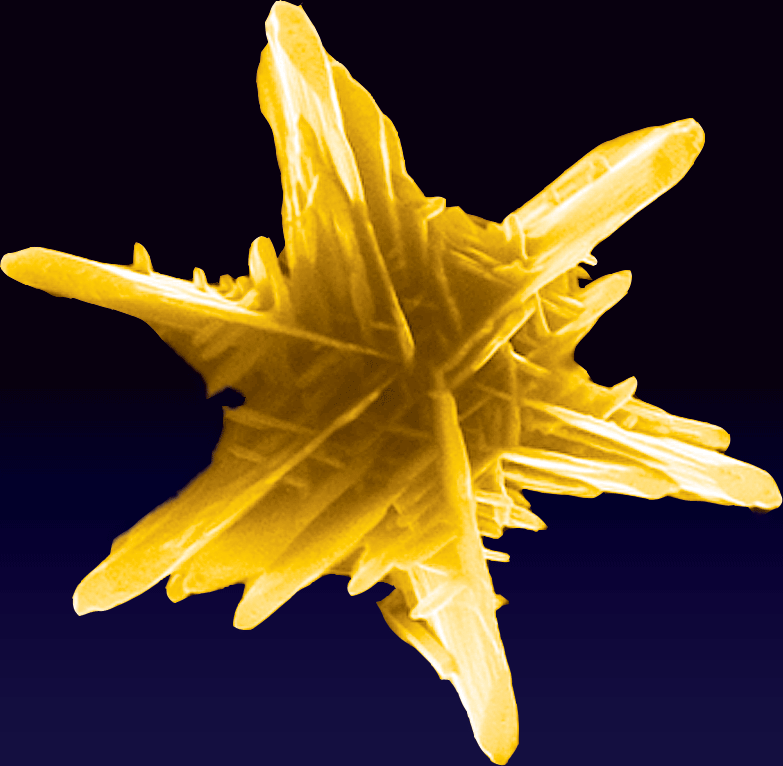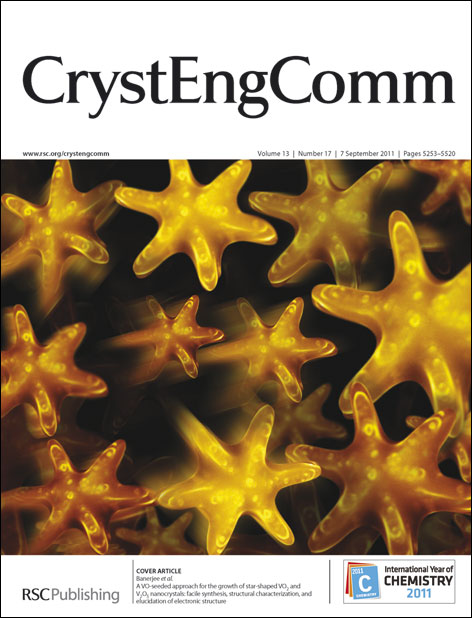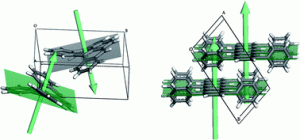 This month’s Crystal Clear shows a vanadia star-shaped nanocrystal.
This month’s Crystal Clear shows a vanadia star-shaped nanocrystal.
The crystal was made by Sarbajit Banerjee and colleagues at the State University of New York, Buffalo. They were making six-armed nanocrystallites of binary vanadium oxides, and although in this particular image the arms aren’t fully separated, we still thought it was a great looking crystal. They used a new seeded growth strategy that was very successful in making controlled shapes with good monodispersity, and you’ll have to read the full paper to see the complete nanostars!
Vanadium oxides are important in technology, partly because the variety of structures they can form makes them invaluable as host lattices, but also because of their interesting electonic, electrochromic, magnetic and optical properties. Vanadium oxides have consequently been used in batteries, as well as optical applications like laser crystals and switching devices.
This paper was published in Issue 17 of CrystEngComm, and was featured on the front cover, read our earlier blog to find out more.
Read the full article for free to find our more and to see the fully formed star-shaped crystals…
A VO-seeded approach for the growth of star-shaped VO2 and V2O5 nanocrystals: facile synthesis, structural characterization, and elucidation of electronic structure
Luisa Whittaker, Jesus M. Velazquez and Sarbajit Banerjee
CrystEngComm, 2011, 13, 5328-5336
 Keep up-to-date with the latest from CrystEngComm by liking us on Facebook.
Keep up-to-date with the latest from CrystEngComm by liking us on Facebook.










 In this HOT article, Chinese researchers synthesized novel polyhedral 26-facet CuS microcages decorated with unique crystalline structures as building blocks via a facile sacrificial Cu2O templates solution route. Each of the polyhedral 26-facet CuS microcages is constructed of three different structural shells, which are enclosed by three pairs of square mesostructural shells, four pairs of nanotwinned triangular shells, and six pairs of rectangular single crystalline shells. The study should be of great importance for the “bottom-up” assembly of unusual hollow ordering superstructures.
In this HOT article, Chinese researchers synthesized novel polyhedral 26-facet CuS microcages decorated with unique crystalline structures as building blocks via a facile sacrificial Cu2O templates solution route. Each of the polyhedral 26-facet CuS microcages is constructed of three different structural shells, which are enclosed by three pairs of square mesostructural shells, four pairs of nanotwinned triangular shells, and six pairs of rectangular single crystalline shells. The study should be of great importance for the “bottom-up” assembly of unusual hollow ordering superstructures. In this CrystEngComm Highlight article Colin Seaton from the University of Manchester looks at the crystal engineering of co-crystals between carboxylic acids. Seaton looks at how Hammett substitution constants can help in the design and creation of multi-component crystalline materials.
In this CrystEngComm Highlight article Colin Seaton from the University of Manchester looks at the crystal engineering of co-crystals between carboxylic acids. Seaton looks at how Hammett substitution constants can help in the design and creation of multi-component crystalline materials.
 A CrystEngComm article by Ben Zhong Tang and colleagues has been highlighted in the weekly ACS Noteworthy Chemistry section:
A CrystEngComm article by Ben Zhong Tang and colleagues has been highlighted in the weekly ACS Noteworthy Chemistry section:


 In this CrystEngComm Hot article Joël Moreau and colleagues create a porous network from a host compound based on spirocyclic triphosphazene.
In this CrystEngComm Hot article Joël Moreau and colleagues create a porous network from a host compound based on spirocyclic triphosphazene.